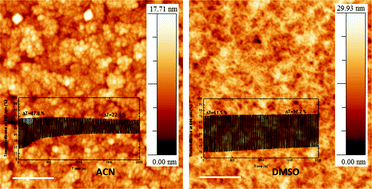The effects of solvent on the electrochromic properties of poly(3,4-ethylenedioxythiophene)†
Abstract
In this study, we have investigated the solvent effect on the electrochromic properties of poly(3,4-ethylenedioxythiophene) (PEDOT). The results suggest a conformational change of the PEDOT chains from the coil structure into a linear structure in methyl sulfoxide (DMSO). This transition enhances the charge hopping in the polymer leading to better conductivity and electroactivity. We believe that these factors are also responsible for the higher electrochromic contrast and efficiency. Moreover, the results also suggest that the linear conformation is more favorable for the ionic transfer during the electrochemical reaction. This can promote the long-term stability of the PEDOT for electrochromic application.


 Please wait while we load your content...
Please wait while we load your content...